1987 Donruss - Lot of (750+) assorted with tons of Hall-of-Famers !!!
Commons book .10 each. If all were commons, break value would be $75 but this lot has tons of Stars, Rookies & Hall-of-Famers.
| Grade |
NEAR MINT to NM/MINT |
| Book Value |
$ 100 |
| Our Price |
$ 19.95
Add to cart
|


Below are short bits & pieces on sportscard & baseball trading card collecting.
Please wander around the website for more info, prices, values & images
on vintage baseball, football, basketball, hockey, sport and non-sports cards.
1961 Topps Baseball Cards
Checklist & Values
The 1961 Topps baseball card set had 587 cards (#1-#598 with some missing numbers).
In addition to the missing cards, 2 cards were accidently numbered #463
(the Braves Team card was supposed to be card #426).
1961 Topps set was packed with special "subsets":
League Leaders (10 cards), World Series cards (10),
Highlights (11 cards), MVP's (16 cards), Checklists (7 cards plus several variations),
Team cards, Special Multi-Player cards, Managers,
Topps Rookie All-Star Trophies, & Sporting News All-Stars
Of note - 1961 Topps were the first cards bearing the very popular Topps Rookie All-Star Award Trophies.
"High Number" cards (#523-#589) are very scarce.
The least attractive aspect of the 1961 Topps baseball card set
were the capless players !!!
Baseball expansion led to the problem when
Los Angeles Angels were added,
the Washington Senators became the Minnesota Twins
and the Washington Senators got a new franchise.
Because of these changes, tons of players were capless
and looked awful. picture you 50 year old grand-dad.
Life was obviously tougher back then.
More 1961 Topps card info:
Card #1 was All-American basketball player Dick Groat
Card #2 was Roger Maris, right before his record breaking 61 Home Run season
Mickey Mantle was on (6) 1961 Topps cards adding to the sets cost.
Topps released 3 other sets in 1961: Topps Dice Game, Topps Magic Rub-Offs & Topps Stamps.
Other issues you may be interested in:
1961 Topps Autographed baseball cards Checklist and Prices
1961 Topps Stamps Checklist and Prices
1961 Topps Magic Rub-Offs Checklist and Prices
1961 Post Cereal Checklist and Prices
1961 Fleer Baseball Greats checklist, values and prices.
1961 Nu-Card Scoops checklist, values and prices.
1960 Topps Baseball card checklist, values and prices.
1961 Topps Baseball card checklist, values and prices.
(You may be on that page now)
1962 Topps Baseball card checklist, values and prices.
|

|
1970/1972/1973 Topps Candy Lids
Checklist & Values
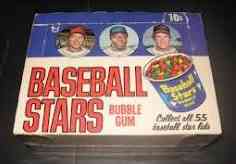
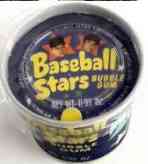
Topps has tried many crazy products, often called "test issues".
Test issues were usually only distributed in limited areas and were difficult
to find. Candy Lids were one of Topps most unusual; little tubs of candy
with player's photos on bottom of the 1 7/8" lids. The 10 cent candy's came 24 to a box.
Sealed tubs can still be found in the $150 to $200 range. Called "Baseball
Stars Bubble Gum", the 1970 Topps Candy Lids set had 24 different
players, while 1973 Topps Candy Lids had 55.
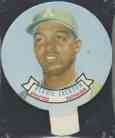
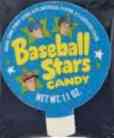
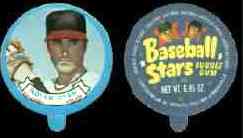 Topps released their first Candy Lids in 1970. The 1970 Topps Candy Lids
are very, very hard to find and had small photos of Tom Seaver,
Carl Yastrzemski and Frank Howard.
Topps released their first Candy Lids in 1970. The 1970 Topps Candy Lids
are very, very hard to find and had small photos of Tom Seaver,
Carl Yastrzemski and Frank Howard.
In 1973 the candy was replaced by gum, the mini photo of Frank Howard was
gone from the top of the lid and team logos were airburshed off the player's
caps. Even the tiny Yaz and Seaver photos logos removed. 1973 Topps Candy
Lids are hard to find, but not nearly as scarce as the 1970's. In 1972
a Topps Candy Lids issue was planned but never released although a few proofs do exist.
 Topps released two other test issue sets in 1973 (1973 Topps Pinups and 1973 Topps Comics).
The 1973 Topps Comics and 1973 Topps Candy Lids shared many photos and again
had no team logos. If thinking "licensing dispute", you are likely right.
Topps received player's union's permission for these test issues, but not
Major League Baseball's. Issues over rights & fees with MLBPA and the player's
union resulted in Topps started shutting down future production of test
issues putting an end to some of their most fun collectibles.
Topps released two other test issue sets in 1973 (1973 Topps Pinups and 1973 Topps Comics).
The 1973 Topps Comics and 1973 Topps Candy Lids shared many photos and again
had no team logos. If thinking "licensing dispute", you are likely right.
Topps received player's union's permission for these test issues, but not
Major League Baseball's. Issues over rights & fees with MLBPA and the player's
union resulted in Topps started shutting down future production of test
issues putting an end to some of their most fun collectibles.
Click for complete
1973 Topps Candy Lids Checklist and Prices
Note: You may be on that page right now.
|

Tobacco Cards
Starting approximately in 1886, sportscards, mostly baseball cards, were often
included with tobacco products, for promotional purposes and also because the
card reinforced the packaging and protected cigarettes from damage. These sports
cards are referred to as tobacco cards in the baseball card hobby. Over the next
few years many different companies produced baseball cards. Tobacco cards soon
started to disappear as the American Tobacco Company tried to develop a monopoly
by buying out other companies.
They were reintroduced in the 1900s, as American Tobacco came under pressure from
antitrust action and Turkish competition. The most famous and most expensive,
baseball card is the rare T206 Honus Wagner. The card exists in very limited
quantities compared to others of its type because Wagner forced the card to be
removed from printing. It is widely (and incorrectly) believed that Wagner did
so because he refused to promote tobacco, but the true explanation lies in a
dispute over compensation.
Soon other companies also began producing baseball and football cards. Sports magazines
such as The Sporting News were early entries to the market. Candy manufacturers
soon joined the fray and reflected a shift toward a younger target audience for cards.
Caramel companies were particularly active and baseball cards were one of the first
prizes to be included in Cracker Jacks. World War I soon suppressed baseball card
production.





 Topps has tried many crazy products, often called "test issues".
Test issues were usually only distributed in limited areas and were difficult
to find. Candy Lids were one of Topps most unusual; little tubs of candy
with player's photos on bottom of the 1 7/8" lids. The 10 cent candy's came 24 to a box.
Sealed tubs can still be found in the $150 to $200 range. Called "Baseball
Stars Bubble Gum", the 1970 Topps Candy Lids set had 24 different
players, while 1973 Topps Candy Lids had 55.
Topps has tried many crazy products, often called "test issues".
Test issues were usually only distributed in limited areas and were difficult
to find. Candy Lids were one of Topps most unusual; little tubs of candy
with player's photos on bottom of the 1 7/8" lids. The 10 cent candy's came 24 to a box.
Sealed tubs can still be found in the $150 to $200 range. Called "Baseball
Stars Bubble Gum", the 1970 Topps Candy Lids set had 24 different
players, while 1973 Topps Candy Lids had 55. 

 Topps released their first Candy Lids in 1970. The 1970 Topps Candy Lids
are very, very hard to find and had small photos of Tom Seaver,
Carl Yastrzemski and Frank Howard.
Topps released their first Candy Lids in 1970. The 1970 Topps Candy Lids
are very, very hard to find and had small photos of Tom Seaver,
Carl Yastrzemski and Frank Howard.  Topps released two other test issue sets in 1973 (1973 Topps Pinups and 1973 Topps Comics).
The 1973 Topps Comics and 1973 Topps Candy Lids shared many photos and again
had no team logos. If thinking "licensing dispute", you are likely right.
Topps received player's union's permission for these test issues, but not
Major League Baseball's. Issues over rights & fees with MLBPA and the player's
union resulted in Topps started shutting down future production of test
issues putting an end to some of their most fun collectibles.
Topps released two other test issue sets in 1973 (1973 Topps Pinups and 1973 Topps Comics).
The 1973 Topps Comics and 1973 Topps Candy Lids shared many photos and again
had no team logos. If thinking "licensing dispute", you are likely right.
Topps received player's union's permission for these test issues, but not
Major League Baseball's. Issues over rights & fees with MLBPA and the player's
union resulted in Topps started shutting down future production of test
issues putting an end to some of their most fun collectibles. 